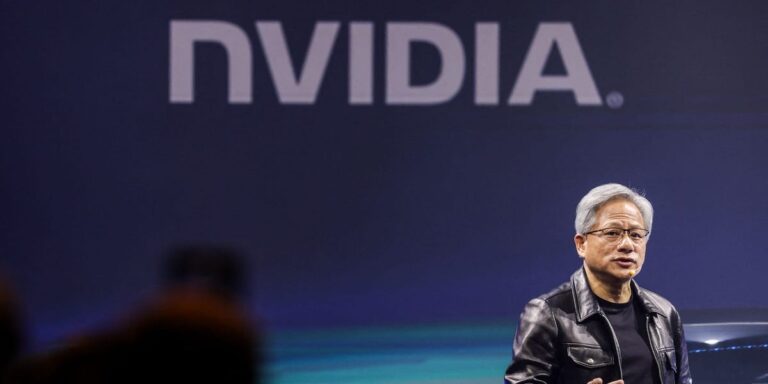Nvidia generated $30 billion in revenue in the second quarter, beating most analysts’ expectations for the period, with nearly half of that coming from just four customers, according to the company’s SEC filing.
Gil Luria, a technology analyst who covers Nvidia at investment firm DA Davidson, told Business Insider that investors should remain cautious over the next year or two.
Just four customers brought in 46% of Nvidia’s total revenue in the second quarter, or about $13.8 billion, according to the company’s filing.
The companies remain anonymous in the filing, and Luria told BI that there are no disclosure laws that require Nvidia to reveal the names of its customers.
But Luria said the likely customers would be Microsoft, Meta, Amazon and Google, all of which are actively pursuing AI efforts and are known to be stockpiling GPUs.
“The only time they’re not one of the four is if one of their customers is a reseller,” Luria said, citing Dell and Supermicro as examples.
An Nvidia spokesman declined to comment, and none of the four alleged customers responded to requests for comment.
Luria said it’s “highly unusual” for a company the size of Nvidia to rely on a small number of customers for the majority of its revenue.
“Other mega-cap companies don’t have even 10% of the customers of the larger companies with market caps over $200 billion,” the tech analyst told BI. As of Wednesday, Nvidia’s market cap was $2.61 trillion.
Luria maintained his hold rating on Nvidia shares, citing concerns about the sustainability of demand.
Jacob Born, technology analyst at Emarketer, told BI that the high level of revenue concentration may be unusual from a broader market perspective, but he said it’s normal for technology companies that offer specialized products like graphics processing units.
Emarketer is a subsidiary of Axel Springer, which also owns BI.
Nvidia said in its 10-Q filing that there has been a period when it generated significant revenue from a limited number of customers and that “this trend may continue in the future.”
In 2004, when Nvidia wasn’t as profitable as it is today, just four unnamed customers brought in 51% of its total third-quarter revenue, according to the company’s 10-Q report. At the time, Nvidia partnered with PC makers like Dell and Sony to provide GPUs for their computers and gaming systems.
Luria told BI that Nvidia has historically kept the same four biggest customers in its data center division — Microsoft, Meta, Amazon and Google — but that’s typically balanced by Nvidia’s gaming and automotive divisions, which have different clients.
“NVDIA has recently seen a significant increase in its data center business as a percentage of its total revenue, resulting in increased customer concentration,” Luria said.
He said this customer concentration should be a top concern for investors over the next year or two for three main reasons:
1. Large companies don’t rely on a single source of truth
Large companies “don’t want to be locked into one vendor in any one area,” Luria said.
“Just like Walmart doesn’t buy all its potato chips from one company, Microsoft doesn’t like to buy its computer chips from one company,” he said.
Microsoft has made that clear before, pointing to how the company has gradually moved away from Intel as its sole processor provider, Luria added.
2. Demand for Nvidia may be temporary
Another reason investors should be concerned is that these big Nvidia customers are suggesting they’re buying more GPUs without worrying about the return on their investment, Luria said.
“Companies have stated that they are ‘overinvesting’ – that is, they are buying without regard for the return on investment, which usually does not last,” Luria said.
Meta CEO Mark Zuckerberg told shareholders during an earnings call in April that it would likely be “several years” before the company’s AI efforts would have any positive impact, so the current rush for Nvidia chips from big customers may be temporary.
That doesn’t mean Nvidia will run out of customers.
Born, the Emarketer analyst, told BI that Nvidia has a long list of customers, from countries to startups, that want to buy its chips.
“Just because a handful of companies currently make up the majority of Nvidia’s revenue doesn’t mean that will continue to be the case,” he said. “New large customers could come in and, of course, nation states could become big buyers of these chips.”
3. Increasing competition
Competition will also intensify for Nvidia.
Google and Meta announced new home-grown chips for AI development earlier this year, Microsoft will unveil a custom AI chip at the end of 2023, and Amazon is developing its own chips to avoid buying expensive Nvidia GPUs, BI’s Eugene Kim previously reported.
“All of these companies are at various stages of adopting their own chips for AI,” Luria said. “Google and Amazon have been there the longest, and their technology is already competitive with Nvidia, with Microsoft and Meta catching up.”

